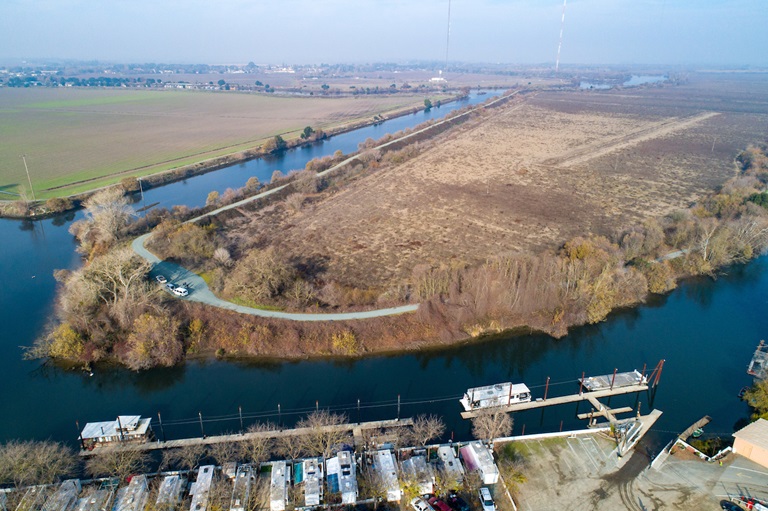Just West of I-5, a Glimpse of the Future of Water Management
Aerial view of McCormack Williamson Tract. DWR/2018
Driving along Interstate 5 south of Sacramento, you wouldn’t notice anything unique about the land stretched out beyond your car window. But hidden between Interstate 5 and Walnut Grove, lies one of the most important environmental restoration sites in the Sacramento-San Joaquin Delta.
It’s a glimpse into the state’s vision for a fully interconnected, climate-resilient water system across California. The McCormack-Williamson Tract is a flood safety project that buffers the surrounding rural community against dangerous floodwaters. But the genius of the project is that the same levee system protecting private property also opens a portion of the floodplain to daily tidal flow, creating new habitat for migratory birds, amphibians and the nearly-extinct Delta smelt.
Californians do not have to choose between water infrastructure and habitat protection. Flood safety does not have to come at the expense of native species. Across the Delta, farmers are working together with state scientists and engineers to design levees that protect homes while providing food and shelter to endangered fish. This project represents a new era at the Department of Water Resources (DWR) that embraces multi-benefit water projects serving both people and the environment.
DWR recognizes this integration as a natural guiding force. The goal of multi-benefit water projects initially took shape as a progressive set of values among water managers. Now it is at the core of the department’s efforts.
The department recently formed a new Division of Multi-Benefit Initiatives to strengthen bonds between people and projects that once worked in isolation. Flood safety officials are closely collaborating with scientists, landowners and other stakeholders to design projects that prioritize the economy, the environment, and take bold action in the face of climate change. It’s a delicate balance, and an exciting direction that relies on leadership from each of DWR’s local and statewide partners.
In demonstrating this commitment, DWR purchased the 1,600-acre McCormack Williamson Tract at the end of May. The sale, which follows two decades of close collaboration with The Nature Conservancy and other partners, marks a commitment by DWR to protect the land in perpetuity. The project is funded through DWR and part of California EcoRestore, a multi-agency initiative to restore ecosystems in the Sacramento-San Joaquin Delta. DWR is the lead agency on 28 of 30 EcoRestore projects; and the McCormack Williamson Tract was one of five projects that launched last year.
In a recent executive order, Governor Newsom called on the state to “harness the best in science, engineering and innovation” in designing a Water Resilience Portfolio. That portfolio will formalize this evolving set of priorities through the 21st century. Fortunately, the Governor’s vision is already being realized in the Delta, where levee systems, natural floodplains, and wetlands function as a coordinated system. The need for public safety, a strong economy, and natural ecological function share equal value as we design an integrated water system for all Californians.
